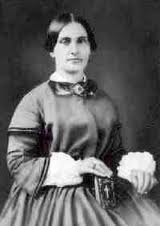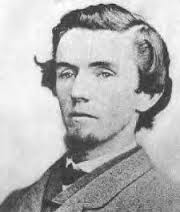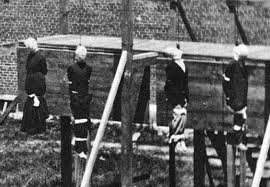 Lincoln Conspirator, Mary Surratt, was hung for her role in the assassination of President Lincoln or was Surratt a pawn in a foiled kidnapping and no more than a Confederate Spy. Whether a Lincoln assassination conspirator, kidnapping accessory, or confederate sympathizer and spy, Mary Surrat was a traitor and her treasonous activities deserved severe punishment, but to be tried by a military commission and condemned to death, as were her boarders and acquaintances, may have been a little harsh, in the extreme. At the mercy of two rational politicians, the likes of, new President Andrew Johnson and Secretary Edwin Stanton, may have foreshadowed Surratt’s sentence before any drum head trial ever commenced.
Lincoln Conspirator, Mary Surratt, was hung for her role in the assassination of President Lincoln or was Surratt a pawn in a foiled kidnapping and no more than a Confederate Spy. Whether a Lincoln assassination conspirator, kidnapping accessory, or confederate sympathizer and spy, Mary Surrat was a traitor and her treasonous activities deserved severe punishment, but to be tried by a military commission and condemned to death, as were her boarders and acquaintances, may have been a little harsh, in the extreme. At the mercy of two rational politicians, the likes of, new President Andrew Johnson and Secretary Edwin Stanton, may have foreshadowed Surratt’s sentence before any drum head trial ever commenced.
Mary Elizabeth Jenkins Surratt was born in May or June of 1820 or 1823 near Waterloo, Maryland. Raised as an Episcopalian, she was educated for four years at a Roman Catholic boarding school in Virginia. She grew up around slavery and accepted it as a way of life. Her parents owned a small plantation, were slave-owners and her father died when she was an infant. Mary’s mother didn’t remarry, instead she successfully managed and expanded the family holdings.
In 1840, Mary married John Surratt, who built a mill near Oxon Hill in Maryland. The family lived for a time with Mary’s mother-in-law in the District of Columbia. In 1852, John built a home and tavern on a large plot of land he’d purchased in Maryland and that also served as the local polling place and post office. In 1853, Mary’s husband, who had developed a severe drinking problem, bought a house in the District of Columbia and rented it out. The family owned several slaves, but John had to sell them to settle business debts, that continued to accumulate due to his poor business judgement and worsening alcoholism. All three of the Surratt children, Isaac, John Jr. and Anna were educated at Catholic boarding schools. In 1854, after John Surratt was appointed the area’s postmaster, the town was renamed Surrattsville.
 In April of 1861, Maryland, although still part of the Union, was a hotbed of confederate sympathizers, including the Surratt family. The eldest son Isaac joined the Confederate army, and John Surratt Jr. was soon working for the Confederate Secret Service as a courier. The tavern in Sarrattsville was known as safe haven for rebel sympathizers and spies. John Surratt died in 1862 from a stroke, leaving Mary burdened with debt. In 1864, Mary decided to move to the house she owned in Washington. The tavern she rented to an ex-policeman named John Lloyd, whose testimony at the trial would supply the key evidence in her conviction. Like the tavern, the boardinghouse soon became known as a safe haven for rebel sympathizers. Son, John Jr. continued his stealthy courier missions for the Confederacy.
In April of 1861, Maryland, although still part of the Union, was a hotbed of confederate sympathizers, including the Surratt family. The eldest son Isaac joined the Confederate army, and John Surratt Jr. was soon working for the Confederate Secret Service as a courier. The tavern in Sarrattsville was known as safe haven for rebel sympathizers and spies. John Surratt died in 1862 from a stroke, leaving Mary burdened with debt. In 1864, Mary decided to move to the house she owned in Washington. The tavern she rented to an ex-policeman named John Lloyd, whose testimony at the trial would supply the key evidence in her conviction. Like the tavern, the boardinghouse soon became known as a safe haven for rebel sympathizers. Son, John Jr. continued his stealthy courier missions for the Confederacy.
About this time, John Jr. was introduced to actor John Wilkes Booth, by another Confederate sympathizer, Dr. Samuel Mudd. Booth, a racist, Confederate fanatic and notorious womanizer, was also from Maryland. John Wilkes Booth, as an actor of national acclaim, who traveled freely between the North and the South and was also known to have transmitted Union intelligence to agents in Richmond. Booth was soon a frequent visitor to Mary Surratt’s boarding house in Washington. The actor was charming, seductive and persuasive. Mary’s daughter Anna became smitten with Booth and rumor has it that Mary might have succumbed to his wiles. John Jr. along with others that frequented the boarding house were soon involved in a plot to kidnap President Abraham Lincoln.
 Booth spent months planning Lincoln’s abduction and most of it was at the Surrat boarding house. He had many private conversations with Mary and soon after Lincoln’s second inauguration, the conspirators determined to kidnap President Lincoln on a nearby rural road, but Lincoln’s route had been changed. Booth was enraged by the failure, since he had already missed an opportunity to assassinate Lincoln at the inauguration.
Booth spent months planning Lincoln’s abduction and most of it was at the Surrat boarding house. He had many private conversations with Mary and soon after Lincoln’s second inauguration, the conspirators determined to kidnap President Lincoln on a nearby rural road, but Lincoln’s route had been changed. Booth was enraged by the failure, since he had already missed an opportunity to assassinate Lincoln at the inauguration.
On the day of the assassination, Booth asked Surratt to deliver a package, which was later discovered to contain firearms, to her old tavern in Maryland. On her way home, Surratt ran into her tenant, John Lloyd. When authorities first questioned Lloyd about their encounter, he did not mention anything significant and denied that Booth and David Herold had visited his tavern. Yet when questioned later, he claimed that Surratt had told him to have whiskey and weapons ready for Booth and Herold, who would be stopping by that night.
Three days after the assassination, on April 17, 1865, Mary Surratt was arrested at her boarding house on H Street. Mary proclaimed her innocence; she denied any knowledge that she knew what Booth had planned. She claimed that her trips out to the tavern were simply to collect a past debt.
Mary Surratt was held at the Old Capitol Prison’s annex and then at the Washington Arsenal. She was brought before a military commission on May 9, 1865, charged with conspiracy to assassinate the president. Her lawyer was United States Senator Reverdy Johnson. After making his jurisdictional plea, Reverdy Johnson turned Mary Surratt’s defense over to Frederick Aiken, a young lawyer with little courtroom experience. Having served as a Union officer, during the previous four years, Aiken was hardly in any position to defend Surratt. Despite his lack of courtroom expertise, Aiken believed the use of a military commission to try his client was highly prejudicial. It wouldn’t matter how innocent or how worthy the defense, Mary Surratt’s fate, as it turned out, was never in the Commission’s hands. President Andrew Johnson and Secretary Edwin Stanton wanted to set an example of the conspirators treasonous acts and prove to the entire nation the end result of revolt and insurrection.
The Commission’s rules required that six of the nine voting members had to agree on the verdict and the sentence. The first vote, in the Surratt case, was five to four to either acquit or to save her life if she were found guilty. That was not the verdict that Stanton and Johnson expected, they suggested a compromise to the tribunal members. If the commission voted for the death penalty, they could immediately thereafter petition the President for clemency. Stanton would make sure the President responded favorably.
Mary Surratt was found guilty on June 29 and 30 by the military court of most of the counts on which she’d been indicted, sentenced to be executed, the first time that the United States federal government had subjected a woman to capital punishment.
Aiken filed a Writ of Habeas Corpus which he presented to Judge Andrew Wylie. When when it was granted, he thought his client might actually have a chance in a civilian court. President Johnson set the writ aside, with this order,
“I do hereby declare that the writ of habeas corpus has been suspended in such cases as this, and I do hereby especially suspend this writ, and direct that you proceed to execute the order heretofore given upon the judgment of the Military Commission.”
Judge Advocate Joseph Holt said he had been in Johnson’s presence when the President read the plea. Johnson was quoted as saying that Mary Surratt “kept the nest that hatched the egg.”
 Mary Surratt was executed by hanging, with three others convicted of being part of the conspiracy to assassinate President Abraham Lincoln, in Washington, DC, on July 7, 1865, less than three months after the assassination.
Mary Surratt was executed by hanging, with three others convicted of being part of the conspiracy to assassinate President Abraham Lincoln, in Washington, DC, on July 7, 1865, less than three months after the assassination.
Louis Weichmann, one of the alleged conspirators who delivered the package with Surratt, was released after he testified against her. He later claimed that the government had forced him to testify. Lewis Powell, a conspirator who was hanged with Surratt, proclaimed her innocence to his executioner minutes before his death.
John Jr. was in Elmira, New York when the assassination occurred, he then fled to Canada and then to Europe, where he served in the Papal Guard. In 1867, Surratt was captured in Egypt and returned to the United States. John H. Surratt, Jr., was later tried as a conspirator in the assassination. The first trial ended with a hung jury and then the charges were dismissed because of the statute of limitations. John Jr. admitted publicly in 1870 to have been part of the kidnap plot which led to the assassination by Booth. Mary’s son always maintained that his mother was innocent, helped plan the kidnapping, but never knew of the assassination.
Mary Elizabeth Jenkins Surratt was the first woman executed by the Federal Government, her acts and lifestyle were treasonous to the Government of the United States, Northern politicians were poised to exact revenge, the media was ravenous for Confederate retribution and public opinion demanded satisfaction for their President’s murder. The debate on Mary Surratt’s fate continues and current legal issues regarding civil jurisdiction versus military tribunal confound Constitutional scholars to this day. Was Surratt a Lincoln Conspirator or just a Confederate Spy?
Bummer


Bummer, just a quick note – I finally pinned one of your posts. I have a Pinterest page called History I Like. Guess who’s Mary Surratt post is on it now? Keep up the good work.
Louis,
Thanks for the recognition. Sometimes its not the subject, not the style, but definitely the passion and truth that inspires a better than average post.
I remain,
Sincerely,
Bummer
I don’t think it makes me a Confederate sympathizer to say this sentence was a severe overreaction, especially in actually carrying it out. As I think you and I have discussed before, Andy Johnson was a hothead who should never have gotten to the Vice Presidency, let alone the big job. Edwin Stanton was lashing out in (what I believe) was his guilty conscience in not saving Lincoln. Mary Surratt was like a lot of people during the Civil War, a Southern sympathizer. At that point, with the war over, we should have been trying to bring them back into the national family, not demonizing them. Abraham Lincoln would have understood that. Her story shows how critical it is who is in charge in a big undertaking like a total war.
Louis,
Couldn’t agree with you more. Stanton had his mind made up inspite of any evidence and if he would have lived longer than age 55, history might have shed a stronger light on the trial. At least he helped out burying Johnson’s future.
Bummer